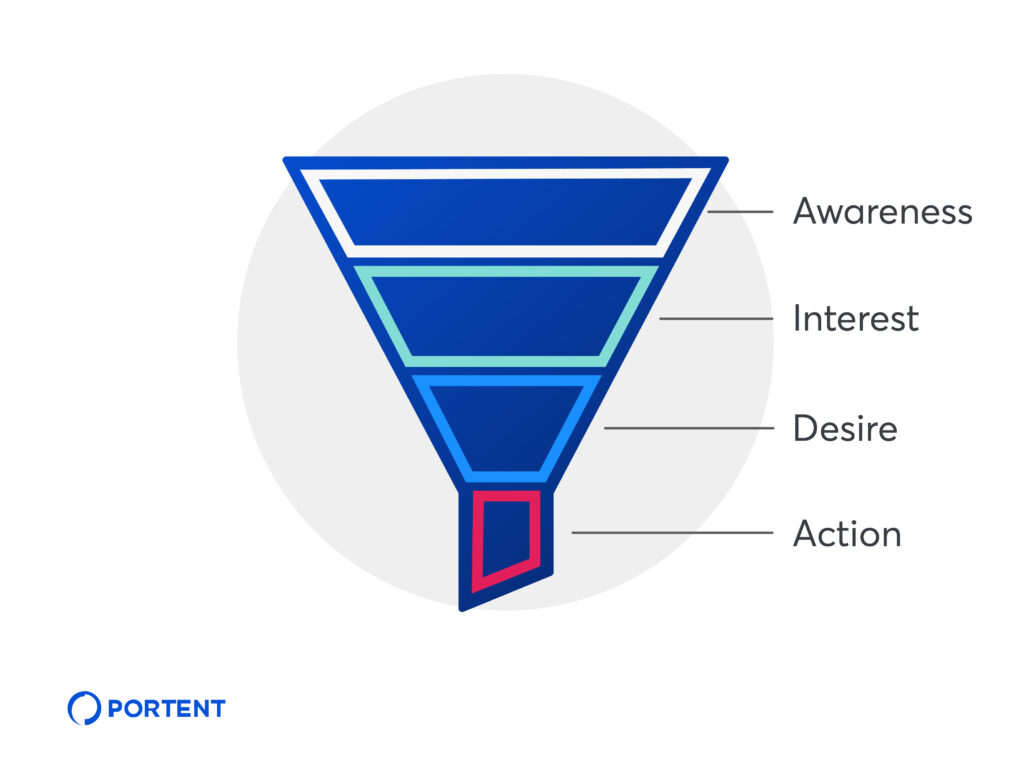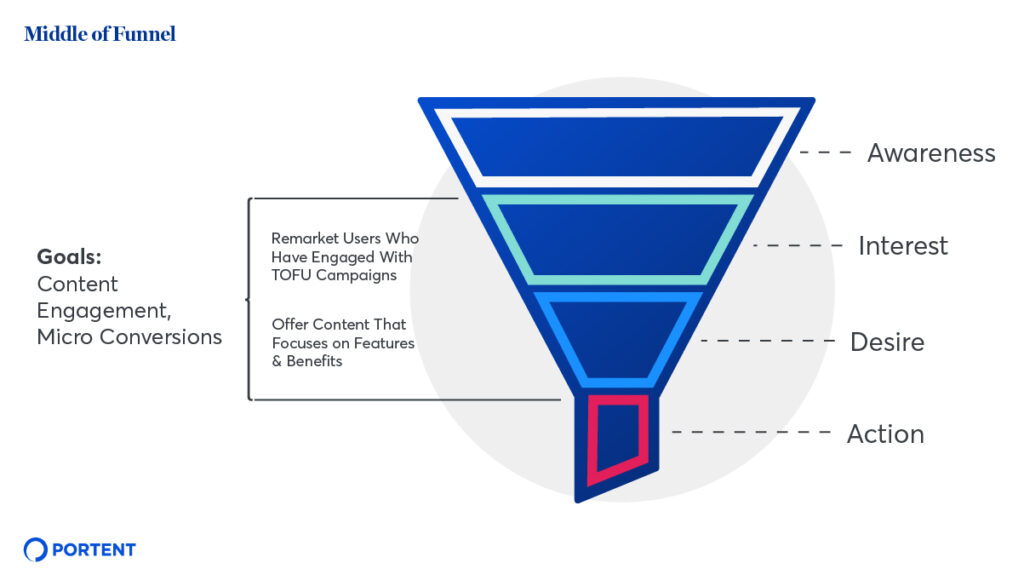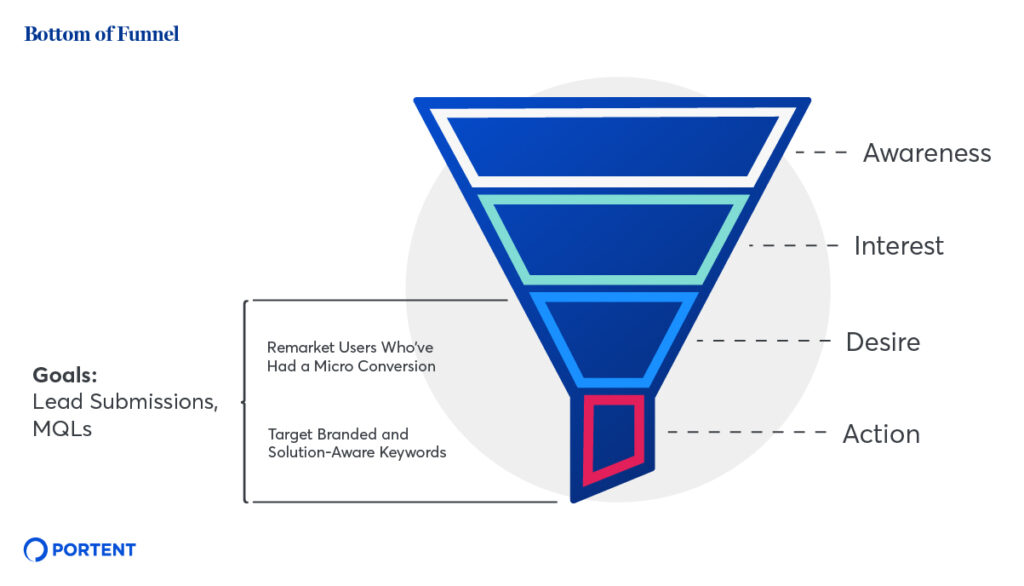I’ve been involved in paid search and paid display advertising for more than a decade, and I can say with confidence that running a B2B account is a whole different ballgame from B2C lead generation or e-commerce advertising. Businesses that sell services or products to other businesses typically have long lead cycles, long sales cycles, and low click-to-sale conversion rates that are only justified by the large amount of revenue associated with each deal closed. Compared to a typical B2C account, there’s far less “hard” conversion data to analyze and optimize from.
Too often, paid search advertisers in the B2B space get so focused on bottom-funnel lead acquisition that campaigns become hard to scale year after year. Using a full-funnel approach can help ensure new users are continually introduced to your brand, that they engage with your on-site content, and that they become qualified leads down the line. In this post, I’ll review why this full-funnel approach is beneficial for B2B advertising and how to implement these tactics appropriately in your account(s).
The Problem – Only Focusing on Bottom-Funnel Campaigns
Scaling B2B accounts year after year is challenging. If you’re dealing with sales cycles of anything longer than three months on average, determining which of your campaigns are actually driving sales – not to mention which attribution model you should be applying – is a convoluted exercise in making educated guesses. Meanwhile, competitors and market forces typically result in continually increasing click costs year after year, forcing you to commit more budget just to stay visible for key terms on the search network.
This is where some advertisers can fall into a trap. With limited quality conversion data and a sole focus on lead acquisition, the rational decision seems to be to shore up a select few competitive search campaigns with enough impression volume and a proven track record in an attempt to keep lead submission volume up.
However, with competitors doing the same thing, those clicks – and thereby leads – become more and more expensive. Meanwhile, brand presence stays static or even shrinks without additional investment in upper funnel efforts. Branded search campaigns become a smaller and small share of impressions, clicks, and lead volume. Costs can spiral out of control, and paid search advertising seemingly becomes a less and less feasible channel to profit from.
The problem here is that there’s a lack of awareness about a business’ brand from new users. Without that initial awareness, it’s hard for said business to convince these users to convert when they’ve moved down the funnel with other brands or resources and are ready to submit a lead. The chances of you or anyone else convincing another business to invest in your brand based on your first interaction with each other are quite slim. At that point, even if they do submit a lead, the onus is then entirely on your sales team to close at high rates to carry your business and justify your marketing budgets.
That’s not a sustainable or winning digital marketing strategy in the B2B space.
The Solution – A Full-Funnel B2B Strategy Scales Up Effectively
The answer to growing your lead volume at scalable rates and budgets year after year is to invest appropriately higher up in the marketing funnel. This gets more new prospective customers to interact with a brand earlier and is more likely to provide dividends as these users move down the funnel.

So, why don’t more B2B advertisers in the paid search and paid display channel do this right off the bat? Besides needing to invest time and resources in creative assets, the typical answer is that higher-funnel campaigns (e.g., brand awareness) are harder to “prove out” using primary key performance indicators (KPIs) such as lead submissions since these campaigns reach new users who aren’t ready to convert yet. Using the same set of KPIs across all of your campaigns can limit your ability to assess how successful your top-funnel and mid-funnel campaigns are, even with a suitable attribution model.
This is where micro conversions come in handy. In our experience, identifying key events that occur on your website that correlate with higher lead submission rates and using those as “conversions” for campaigns that target users higher up the funnel is an excellent way to acquire new and qualified prospective customers effectively. Using these events as conversion signals for campaigns that are not supposed to produce lead submissions right away tells these campaigns’ bidding algorithms that they’re doing their job.
Instead of using limited lead submission data, these micro conversions help you prove that investing in a full-funnel strategy is worthwhile – since these events correlate with higher lead submission rates, it’s easier to see your lead submission volume growth over time and trace that growth back to the micro conversions you acquired from these same users earlier in their journey. This gives you the flexibility to rely on different calls to action and still be able to measure your campaigns’ success appropriately.
Proof in Numbers
This isn’t just a theory – we’ve executed several full-funnel strategies for our B2B clients and have numbers to prove it works. Our paid social team recently provided their own overview of implementing a full-funnel B2B strategy on platforms such as Facebook and LinkedIn. In addition to the excellent results the paid social team has had, our team has also produced impressive numbers.
First, let’s take a look at a full-funnel approach we ran for a B2B solution targeting mid-sized companies. These campaigns had a significant impact on new user acquisition as well as eventual lead generation compared to the previous set of campaigns which were exclusively tailored to bottom-funnel calls to action and conversions:
| Metric | FY2021 | FY2022 | Change |
| Cost | $3.98 Million | $2.97 Million | -25% |
| Users | 1.06 Million | 2.17 Million | +104% |
| Micro Conversions | 14.6k | 75.9k | +455% |
| Lead Submissions | 6.9k | 60.1k | +870% |
Next, let’s take a look at a similar approach we ran for an enterprise-level B2B solution targeting larger companies. Once again, these new campaigns had a significant impact on results compared to the prior set of campaigns geared towards the bottom of the funnel only:
| Metric | FY2021 | FY2022 | Change |
| Cost | $1.29 Million | $549k | -58% |
| Users | 613k | 641k | +5% |
| Micro Conversions | 5.7k | 55.3k | +888% |
| Lead Submissions | 3.1k | 12.8k | +413% |
In both cases, we saw users grow, micro conversions grow, and lead submissions grow at even more efficient costs. Driving more traffic higher up the funnel with appropriate CTAs, landing page experiences, and micro conversions led to more eventual lead submissions at a lower average cost per lead.
You may be looking at those numbers and asking yourself, “alright, how do I set this up in my account?” That’s a great question. Below, you’ll find an overview of how to implement top-funnel, mid-funnel, and bottom-funnel campaigns for your B2B paid search and paid display advertising efforts, including campaign types, calls to action, and key performance indicators to use.
Top of Funnel Campaigns for B2B
Before you can move users down the funnel, you need to get them into the funnel in the first place. Top-funnel campaigns target users who aren’t searching for anything related to your business but share qualities with known prospective customers.

Campaign Types
- Display, discovery, video, and native advertising campaigns on the display network that focus on introducing new users to your brand, your purpose, and your story.
- Dynamic search and performance max campaigns targeting blog posts or other pieces of informative content that get a high level of engagement on your site and correlate with eventual lead submissions at higher-than-average rates.
Calls to Action
CTAs should focus on “learning more” – keep it as a low barrier to entry, so users don’t feel like they have to commit to something right away. Make sure you don’t gate content or ask users for any of their contact information just yet.
Key Performance Indicators
KPIs should be focused on user engagement with on-site content, such as time on site, pages per session, and bounce rate, along with ad click-through rates or view rates (for video ads).
Middle of Funnel PPC Campaigns for B2B
Once you identify users who show genuine interest in your business through either their previous interactions on your website or their intent via search queries, you need to offer these users something of value that entices them to move closer to taking action and submitting a lead.

Campaign Types
- Display and discovery campaigns using relevant in-market and/or life event audiences, as well as similar audiences built off any customer match lists you have uploaded to your account. Furthermore, you can and should use remarketing audiences of users who’ve had initial interaction(s) with your website but haven’t engaged heavily with your site’s most important content, such as your primary services pages.
- Search campaigns that cover “problem-aware” non-branded keywords (i.e., “best digital marketing strategies” versus “digital marketing agency”). These campaigns target users who show some level of interest and/or intent in what your services are and how they can benefit from them.
- Dynamic search and performance max campaigns targeting content that focuses on the features and benefits of what your business has to offer, on common concerns or obstacles your sales team encounter from qualified prospective customers, and on positive reviews, testimonials, or case studies (“social proof”).
Calls to Action
CTAs can lead to lower-funnel content (i.e., pricing options) but should stay away from a direct ask to convert.
Key Performance Indicators
KPIs should focus on user engagement with your on-site content, micro conversions, and assisted leads.
Bottom of Funnel PPC Campaigns for PPC
At this stage, you should have a pool of users who have demonstrated repeated interest in your business and show intent to submit a lead. These campaigns should be focused on acquiring lead submissions directly.

Campaign Types
- Display, Discovery, and Video (Action) campaigns that use remarketing or customer match audiences of users who’ve processed a micro conversion and/or who have engaged with your site’s primary pages (i.e., services, features, specifications).
- Search campaigns that cover “solution-aware” non-branded keywords (i.e., “digital marketing agency” versus “how to do digital marketing”) as well as branded keywords. These campaigns should target users with the highest level of intent to convert.
Calls to Action
CTAs should focus on direct asks for a contact or lead submission, interest in a demonstration or speaking to a representative, and potentially pricing or subscription specifics.
Key Performance Indicators
KPIs should focus on lead submissions and marketing qualified leads, including lead submission rate and cost per lead.
Conclusion
In addition to implementing a full-funnel strategy, you can and should use offline conversion tracking from your CRM to provide your campaigns with more accurate data about which leads advance through your sales funnel and which leads actually turn into closed deals for you (along with how much value is actually generated). Giving your campaigns these value signals will allow you to leverage automated bidding strategies such as Maximize Conversion Value and Target Return on Ad Spend (ROAS) more effectively.
A full-funnel approach to B2B paid search and paid display marketing can help escape the vicious cycle of ever-increasing search click costs and shrinking impression volume. You can and likely will scale up effectively if you follow the implementation guide above.









